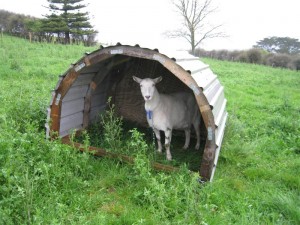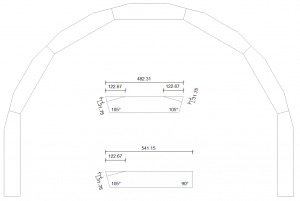I recently had to build a shelter for my Goats and decided to build something with a curved roof.
I’ve also calculated wind loadings for this design – see the end of this post.

There are many similar designs available, but most used a 2×6″ timber, while I wanted to build something with 2×4″ which I had lying around.
I haven’t weighed the shelter, but it’s light enough for two people to be able to drag it – The trick being that you lift the weight off the front of the skids before dragging it.
The shelter is based around a 900mm radius semi circle. The semicircle is elevated by 300mm, making the curved part 1200mm high and 1800mm wide. The whole thing sits on two 100×100 treated timber skids. I made my shelter 1800mm long – this is one of the standard lengths of 100×100 treated posts.
I made my shelter out of three arches. I left one end wide open and the other was covered with a piece of treated ply wood. The two skids are spaced correctly with some 100×50 timber. The plan is at some stage to put a floor in, but so far it seems fine with just a spacer at each end.
Here is a scaled drawing of the pieces for the arch.

Note that the lengths are given to something silly like 2 decimal places. This isn’t critical, just round to the nearest mm (or half if your eyesight is good enough). The important bit is to be consistent between all the pieces.
If you make one with three arches like me, you’ll need 15 of the upper piece (with two angles cuts) and 6 of the lower (one angled, one 90 degree cut) pieces. 100x50mm is the best but it will work with other timber. The dimensions given in the drawing are critical, the lengths which aren’t given are not important at all.
I made up a 105/75 degree jig from a couple of pieces of spare wood. You’ll soon realise you have to cut 36 (for three arches) fairly critical 105 degree angles, so a simple jig makes this a breeze. For the wedged pieces, I basically rough cut 15 pieces of around 550mm, cut one 105 degree end on all them before adding a “stop” to my jig and cutting the other ends. It must’ve taken me about 10 minutes to get it right for the offset of the blade to the side of my circular saw, but once made, it was very quick to make all the pieces.
I nailed the wedge pieces together using nail plate from my local hardware shop. I ended up using 42 ~80mm long nail plates. It was cheaper to buy some ~320mm long plates and cut them into four with tin snips.
I also cut a 45 degree wedge at each end of each skid. These help with dragging the whole structure.
As for the roofing, I used a standard metal roofing with 760mm wide coverage. I needed 5 lengths of it, of which two of them had a double overlap. It requires about 4 and a half lengths.
If you decide to make one, good luck and feel free to ask questions in the comments.
WIND LOADINGS
I was concerned about the wind loading of this shelter due to the windy area we live in, so I calculated the wind load directly onto the flat end face of the shelter in winds of 100 Kilometres per hour.
At 100Km/h, the wind loading will be 110Kg. This is unlikely to be a problem as the force vector would be predominantly horizontal – This would cause the skids at the lee side to “dig in”. In extremes, the end of the shelter may lift, but this would cause the end to tilt, effectively reducing the drag coefficient. Winds hitting the sides of the shelter have a far lower effective force due to the curved shape and lower drag coefficient.
My workings for the wind load onto the end of the shelter are based on the following:
1.2 kg/m³ = Density of air at sea level
27.8m/s = 100km/h in metres per second
1.28 = Cd (Drag Coefficient) of a flat face
1.812m² = Area of end of shelter
9.8 = Newtons per Kilogram
Fd = (rho * v² * A * Cd) / 2
Fd = (1.2 kg/m³ * 27.8 m/s * 27.8 m/s * 1.812 m² * 1.28) / 2
Fd = 1075.5 Newtons = 109.75 Kg

